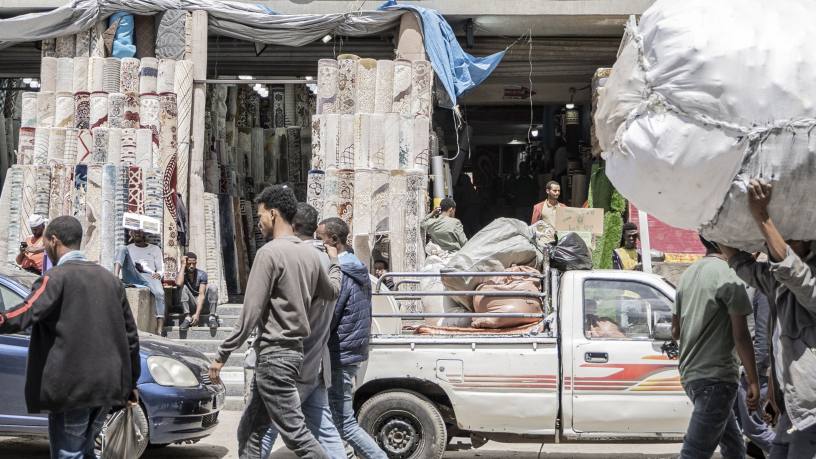After two years of vicious civil war, Ethiopians can dare to dream of a return to something approaching normal life in 2023. The November 2022 truce between Abiy Ahmed’s federal government and the leadership of the northern state of Tigray remained intact as The Banker went to press in late January. Phone and internet services in Tigray have been partially restored, with food and medicine being delivered to the state’s beleaguered population.
Beyond an end to the fighting that has claimed thousands of lives, the truce reawakens hopes for the resumption of the country’s bold market-led economic reform programme, announced in 2018, which followed decades of successful state-led development.
The government has announced plans to allow foreign involvement in the banking sector for the first time in recent history, following the landmark liberalisation of the telecoms sector in 2021, attracting interest from banks in the region and beyond.
The success of such reform measures remains far from certain, however; key initiatives such as the liberalisation of the country’s exchange rate and a sell-off in shares in large state-owned enterprises have been delayed, with the government preoccupied by the Tigray conflict, the impact of Covid-19 and climate change events that have ravaged much of the Horn of Africa.
The conflict has delayed efforts to secure an agreement on Ethiopia’s mounting foreign debts, together with negotiations with the International Monetary Fund (IMF) over access to fresh funds. And while the November ceasefire remains in place, the underlying causes of the conflict remain largely unresolved, raising questions about the durability of the peace.
Economic promise
In the years preceding the civil war, Ethiopia had been the international poster child for the development-state model in the 21st century. The state’s heavy investment in infrastructure, agriculture and industry — replicating in large part the model successfully employed by several east Asian states in the post-second world war era — saw Ethiopia’s economy grow by 850% between 2004 and 2019, compared with a 260% growth for sub-Saharan Africa (SSA) as a whole, according to the World Bank.
Abiy Ahmed’s election as prime minister in 2018 marked a shift towards a more market-driven approach, with the limits of the development-led model becoming apparent amid rising commercial borrowing and loans from China.
The new government recognised that a change in approach was required to bring greater fiscal returns
“The development-state approach used by Ethiopia was much more reliant on inflows of capital than was the case in much of Asia, where savings rates are much higher, requiring the country to take on greater levels of debt,” says Stefan Dercon, the director of Oxford University’s Centre for the Study of African Economies.
“The new government recognised that a change in approach was required to bring greater fiscal returns and ensure that growth is sustainable.”
This change in approach was codified in the government’s Homegrown Economic Reform agenda, announced in September 2019. The programme, set to run for 10 years, contains a sweeping series of measures including the partial privatisation of sovereign-owned enterprises, liberalisation of key industries, and the reform of domestic foreign exchange (FX) and finance markets.
Despite a few early successes — including the licensing of the country’s first foreign-owned finance company in 2019 and the auctioning of the country’s second mobile telecoms licence in 2021 — the reform programme has yet to hit its stride, given the outbreak of the war in Tigray in 2020. The conflict saw overseas donors withdrawing billions of dollars’ worth of support for Ethiopia, with the US removing the country from its African Growth and Opportunity Act trade preference programme.
The economic hit from the war has been exacerbated by the Covid crisis and the impact of climate change, including severe droughts and east Africa’s worst locust swarm in 25 years. Rising food costs, exacerbated by the war in Ukraine, pushed inflation up to an average of 34% in 2022, according to Fitch Ratings.
While escaping recession, the country’s economy has contracted sharply, slowing to its lowest level in nearly 20 years, with growth in 2022 likely to be barely above the SSA average (see chart).
FX reserves meanwhile are dangerously low, dropping to less than one month’s worth of imports in 2022, according to IMF estimates. In October, the country’s Ministry of Finance introduced restrictions on foreign currency use for imports, including alcohol and cars, with priority given instead to importers of raw materials for manufacturing, food and medicine. At time of writing, dollars change hands on the black market at a roughly 70% premium to the official rate of around 53 Ethiopian birr.
The shortage of foreign currency has delayed the liberalisation of the country’s FX market. High-profile privatisations — including those of Ethio Telecom and Ethiopian Airlines, the continent’s largest aviation provider — have also been postponed.
“The stabilisation of the macroeconomic situation is the government’s key priority for the first six months of 2023, ahead of the fiscal reforms and privatisations that have been previously signalled, even though their commitment to such reforms remains unchanged beyond the short term,” says Mr Dercon.
Such macroeconomic stabilisation is of course reliant on a lasting peace in the country that is satisfactory for both the federal government and the leadership in Tigray.
“By November, both sides seem to have made the calculation that it would be too costly to keep trying to achieve their objectives on the battlefield, and therefore returned to the negotiating table. As long as that calculation remains, there’s a good chance that the ceasefire will hold,” William Davison, a senior analyst for Ethiopia at Crisis Group, told The Banker.
While the short-term implementation of the peace deal looks promising thus far — Tigray fighters began handing over their weapons to the government in early January — the longer-term prospects remain uncertain.
“Ultimately, the disagreements between the federal and Tigray leadership that dragged the country into civil war in the first place remain unresolved, and have only been compounded by the Amhara takeover of part of Tigray, Eritrea’s involvement and atrocities on all sides. So, normalisation is going to be difficult to achieve in anything like a timely and smooth fashion,” says Mr Davison.
Debt restructuring
The government is hoping that the end of the war will bring a new impetus to efforts among the international community to restructure the country’s debt, which stood at around $28bn at end-2022. Of this, $19bn is owed directly by the central government, with the remainder owed by various state-owned enterprises, according to Fitch Ratings.
In early 2021, Ethiopia became one of the first countries in Africa to apply for debt relief under the G20’s Common Framework initiative — introduced the previous year in the midst of the Covid crisis — which enables debts held by both public and private lenders to be restructured, with parts written off in extreme cases.
While a creditor committee was formed in September, it has produced little beyond an August 2022 commitment to debt relief.
“The fact that the creditor committee has met four times without reaching agreement since being convened in 2021 suggests that there is disagreement over how to proceed,” says Jermaine Leonard, a primary rating analyst at Fitch Ratings.
Fitch downgraded Ethiopia’s sovereign rating to CCC– in December, reflecting a decline in the country’s external liquidity and “the lack of identified external financing necessary to meet substantial external financing gaps”.
The IMF has yet to agree a fresh credit facility with Ethiopia, following the expiry of the previous facility in late 2021, with fund officials unable to undertake a debt sustainability analysis. Yet, the IMF did visit the country in June 2022, with a fresh deal predicted this year, according to Fitch predictions.
“Ethiopia does not have a solvency issue, it’s more of a short-term liquidity issue,” state finance minister Eyob Tekalign Tolina told Reuters on the sidelines of the IMF meetings in Washington in October, while declining to discuss how much support the country was seeking from the fund.
Despite the challenges facing the economy, the prospect of private sector involvement in the country’s banking sector is an enticing prospect for foreign investors, and is likely to provide a source of valuable foreign currency for government coffers.
First announced in September, exact details of the plans have yet to be finalised, with early signs indicating that foreign lenders will be permitted to set up branches and subsidiaries in the country, and take up to 40% equity stakes in existing lenders. Lenders offering expertise in sectors such as agriculture, housing and infrastructure will be particularly favoured, according to comments made by Solomon Desta, National Bank of Ethiopia’s deputy governor of financial institutions supervision, reported by the local press in November.
The country took initial steps to liberalising the sector in 2019, permitting banks to offer minimal services via representation offices. Around 12 lenders — including Commerzbank, Deutsche Bank, Ecobank, Standard Bank, the European Investment Bank, the Export-Import Bank of India and the Export-Import Bank Korea — have set up such offices in the country.
Yet it is perhaps lenders in neighbouring Kenya — notably KCB and Equity Bank — that are most eager to scale up in Ethiopia. Having both established representation offices, Kenya’s two largest lenders are set to open another new competitive front outside their overbanked home market. Neither Equity nor KCB responded to requests for comment.
“The Kenyans are literally knocking on the door, waiting for the sector to open up, given the huge potential of the market,” says an economist based in the Ethiopian capital, Addis Ababa, who asked not to be named.
According to National Bank of Ethiopia data, the country’s banking landscape is made up of 30 lenders as of end-June — a figure that is believed to include representation offices of local banks. State-owned Commercial Bank of Ethiopia manages more than half of the outstanding credit in the sector, with the country’s remaining commercial banks being largely regional in focus. Assets in the sector have nearly tripled in the past three years, standing at 2.4tn birr ($44.75bn) at end-June.
Mobile money
Despite such growth, account ownership in the country remains low. According to the most recent data available, the 2017 edition of the World Bank’s Global Findex survey, just 35% of adults in the country had a bank account, compared with 82% in neighbouring Kenya at the same date.
Kenya’s relatively high banking penetration stems in no small part from the explosion of mobile money services in the country in the past 15 years. In Ethiopia, by contrast, mobile banking and payment services remain in their infancy.
Ethiopia’s first mobile banking and payments service — M-Birr — launched commercially in 2015 and is offered by six of the country’s largest microfinance institutions. Other mobile payment services have followed suit, notably Telebirr, a mobile money platform launched by Ethio Telecom. Supporting a range of services including cash transfers, payments, airtime top-ups, micro-savings and micro-credit, Telebirr had more than 25 million subscribers as of November.
Over-regulation of both telecoms and payments has stifled the potential for mobile banking in the past, according to Danson Njue, a Nairobi-based senior research analyst for African markets at Omdia. Yet, both markets are set for substantial growth following the commercial launch of services by Kenya’s Safaricom as Ethiopia’s second mobile operator in October. Significantly, the government has also given Safaricom the green light to offer its hugely influential M-Pesa mobile money service in the country.
“The Ethiopian market has a huge opportunity for mobile fintech due to the relatively low levels of financial and digital inclusion when compared to other regional countries. As such, Safaricom has a great opportunity to replicate the Kenyan success of M-Pesa in Ethiopia,” Mr Njue told The Banker.
“However, this can only happen if the regulatory environment remains favourable and the challenges of digital awareness and low mobile penetration rates are tackled.”
Ethiopia had 67 million mobile subscriptions and a mobile penetration rate of 57% at end-2022, according to Omdia data.













